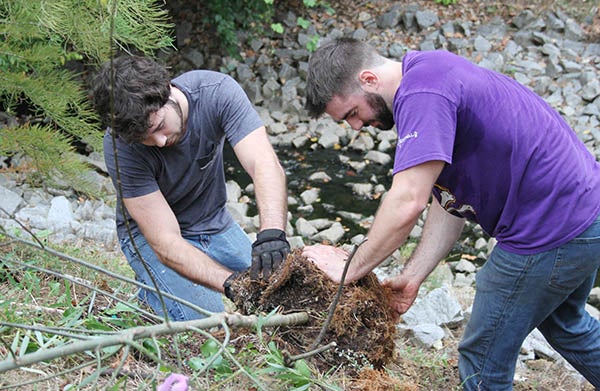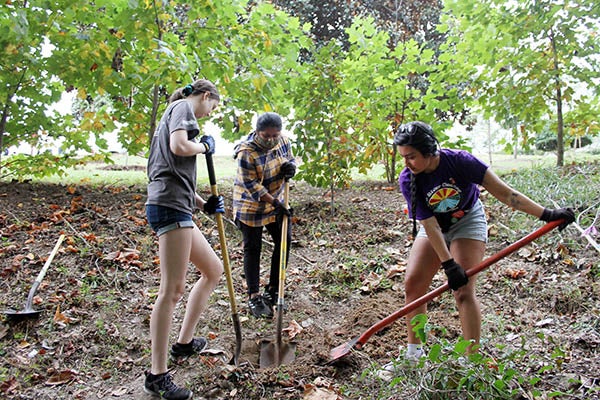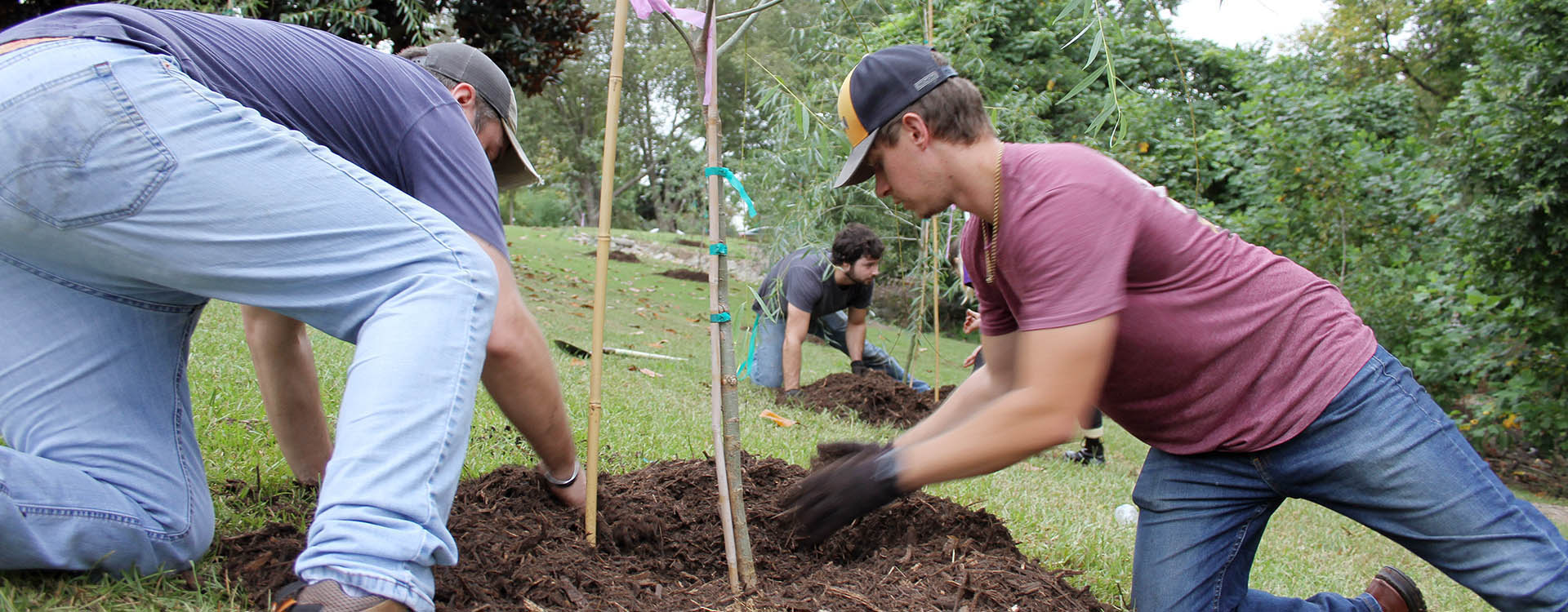ECU engineering students plant trees to mitigate pollution
As water flows down Town Creek toward the Tar River in Greenville, it suddenly turns an odd brown color. A sheen floats on top.
Of course, not too many people make their way down the steep embankment near East Carolina University’s Willis Building to see the discoloration that is caused by a problem that dates back decades — well, except for a team of ECU engineering students.

East Carolina University senior engineering students Alexander Goble, left, and James Riddle plant a willow tree along Town Creek in Greenville on Oct. 7 as part of their capstone project. (Photos by Ken Buday)
Alexander Goble, James Riddle, Adam Till and Noah Weaver looked at the problem as part of their senior capstone project. Their work resulted in the planting of 35 willow trees on the embankment near the creek in an effort to mitigate the pollution.
“Someone thought they had spilled gasoline in the river,” said Dr. Mike O’Driscoll, associate professor in the Department of Coastal Studies and the associate director of the Water Resources Center. “They found out when they put a bunch of these wells in around town that there was a lot of gasoline in the water, so there’s a big plume in the groundwater where the gasoline had migrated, and it all comes into the river here.”
O’Driscoll said the gasoline in the ground came from leaking underground tanks.
“Thankfully they removed the tanks so the continuing source has stopped, but all that gasoline that had spilled over the years is still coming in to the river,” he said. “The fact that it’s been continuous since the 1980s says there were pretty big holes in the tanks, and it had been leaking for a long time. When you come out on a hot day, you can smell the gasoline. You’re really not supposed to be breathing in those vapors.”
As part of degree requirements in the Department of Engineering, senior students must collaborate on a project that can include everything from design and product development or modification to manufacturing and conservation.
“We touched on a couple of topics,” Goble said. “Originally, we were going to do some sort of mechanical process, but we were trying to find something practical, something that we could actually make happen for a project.”
That’s when they came across the Town Creek project.
“We didn’t want just a theoretical application,” Till said. “We wanted to see something done, and this is in the ground, and it makes a difference.”
The project started with research. They learned that in the 1990s, groundwater had been pumped to a wastewater treatment facility, but in the end, the cost of this particular method proved too high and the effort ended, so the team rejected the concept of a similar solution this time around.

Student volunteers dig a hole during a tree-planting project along Town Creek.
They then looked toward the military, which has been in the process of cleaning up its installations with similar problems. They looked at hydra remediation studies and learned that the planting of trees helps in the absorption of benzene, an organic chemical compound that is in gasoline. They then looked at various types of trees before determining that the willow offered the best solution.
“Mostly it was trying to find tree species that would work for where we were planting them,” Goble said. “It’s close to water, and we needed something to absorb higher levels than normal of benzene.”
So on a warm morning, the students joined with ECU facilities workers and volunteers with ReLeaf, an ECU student organization that promotes the planting of tress and protection of forests in urban areas, to plant the 35 willow trees. Armed with shovels, pickaxes and wheelbarrows, the team completed the task in about two hours, half the time they had expected.
“We got done quicker than we thought we would,” Goble said. “It was definitely work. We’re lucky we had so many people come out today. I was really thankful for that.”
O’Driscoll said the idea of “green” solutions to such problems is continuing to grow.
“Natural solutions, where the main thing is finding solutions where you work with natural materials, it can be more sustainable as far as managing some of these water quality problems,” he said. “There’s a lot of interest in doing more of this.”
He said not only will the trees put a dent in the amount of gasoline making its way into the creek, but it also offers a cost savings to the maintenance budget. Previously, the grass embankment had to be routinely mowed. Once the trees mature, that will no longer be the case.
“I think it will look prettier too,” Goble said.
O’Driscoll, who oversaw the project, commended the engineering students for their work.
“Between pandemics and flooding, just starting off was difficult,” he said. “They definitely did their jobs.”

Adam Till, left, and Noah Weaver spread mulch around a willow tree they helped plant near Town Creek.